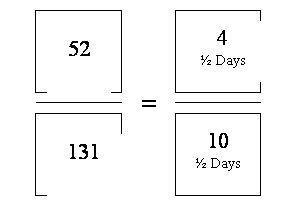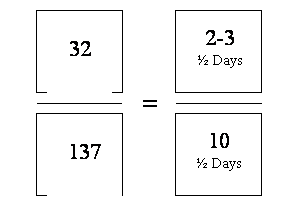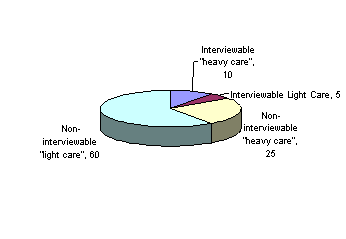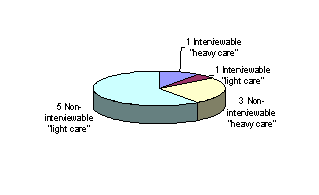renewal cycles. Complete
some now & some later.
and Get 25% off
the Total price!
Buy 3 Courses
and Get 30% off
the Total price!
Buy 4 Courses
and Get 35% off
the Total price!
| Create Account | Login | |

Instructor’s Guide
for DVD Inservice Training
Table of Contents | NCCAP/NCTRC CE Booklet | Administrator Post Test
DVD TRACK 1
IMPORTANT NOTE: Since this DVD was recorded in a hotel meeting room, and not a studio, the audio and video have been digitally optimized as much as possible. However, the features of the speaker’s face will appear blurry at times. This will not hamper your learning experience. The quality of the content speaks for itself.
Using a Partial Calendar
Who are your bedridden, non-group residents?
When do you work with them?
What do you do with them?
Sample Partial Calendar from DVD
Time |
Mon |
Tues |
Wed |
9:00a |
Mental & Sensory Stim. (I) |
Shopping & Book Cart (I) |
Crafts (G) |
1:30p |
Service Project (G) (I) |
Bingo (G) |
Game & Craft Cart (I) |
Sample Calendar
Time |
Sunday |
Monday |
Tuesday |
Wednesday |
Thursday |
Friday |
Saturday |
8:00 |
|
|
|
|
|
|
|
8:30 |
|
|
|
|
|
|
|
9:00 |
Church (G) |
Mental & |
Shopping & |
Crafts (G) |
Clubs (I) (G) |
Room |
Manicure (I) |
|
|
Sensory Stim. |
Book Cart (I) |
|
|
Exercises (I) |
|
|
|
(I) |
|
|
|
|
|
|
|
|
|
|
|
|
|
1:30 |
Service Proj. |
Service Proj. |
Bingo (G) |
Game and |
Mental and |
Resident |
Bingo (G) |
|
(G) |
(G) and (I) |
|
Craft Cart (I) |
Sensory Stim. |
Council |
|
|
|
|
|
|
(I) |
(G) (I) |
|
If you have a volunteer who needs constant ‘hand-holding,’ what might you do to solve this problem?
Recruit another volunteer specifically to work with the original volunteer.
QUESTION #1: To have a structured bedridden one-to-one program, what three questions must be answered?
Who are your bedridden residents?; When do you see them?; and What do you do with them?
DVD TRACK 2
Analysis of Resident Population
A Loner is…
A resident who cannot or will not leave his or her room, whose social needs are not met by the group activity program.
Socially Independent residents have…
Their social needs met through other means than group activities.
A ‘Group’ resident is…
A resident who participates in your group activities program.
Loner |
Socially Independent |
Group |
1. 2. 3. |
1. 2. 3. |
1. 2. 3. |
How might you indicate on the chart that a resident has characteristics of more than one group?
If a resident only goes to religious group activities, such as Bible Study, you might put the resident in the group column, with a question mark after. You might put “rel” after the resident’s name to indicate their preference.
How many group activities per week should a resident attend in order for it to be considered that the group program is meeting their needs?
According to the speaker, 3 activities. However, each resident may differ in the number of activities he or she needs to meet his or her social needs.
Alternative Analysis of Resident Population
Place each resident in your facility into one of the categories below. If behavior varies or is between two categories, place a question mark after the name.
A. Interviewable residents who are relatively physically independent (“light care” residents). – These residents may need assistance in grooming and dressing, but can function relatively independently in transferring/mobility, using the toilet, and eating.
B. Interviewable residents who are relatively physically dependent (“heavy care” residents). – These residents generally require extensive staff assistance in transferring/mobility, using the toilet or catheter care, and eating.
C. Non-interviewable residents who require staff supervision or cuing to maintain independent functioning but do not require extensive or total staff assistance to perform activities of daily living (“light care” residents). – This group includes residents with dementia whose disease has not progressed to a stage requiring extensive or total staff assistance with activities of daily living.
D. Non-interviewable residents who require extensive or total assistance to perform activities of daily living. – These “heavy care” residents have some degree of cognitive impairment and require extensive or total staff assistance in mobility/transferring, using the toilet or catheter care, and eating.
Interviewable |
Interviewable |
Non-interviewable |
Non-interviewable |
1. |
1. |
1. |
1. |
2. |
2. |
2. |
2. |
3. |
3. |
3. |
3. |
4. |
4. |
4. |
4. |
5. |
5. |
5. |
5. |
6. |
6. |
6. |
6. |
QUESTION #2: What is the difference between a “Socially-Independent” resident and a “Group” resident?
Though a Socially-Independent resident can socialize with other residents or roommates, he or she does not attend group activities.
DVD TRACK 3
The Finding Time Ratio
What percentage of a resident population can you expect to be loners?
About half of a resident population are usually loners.
What are the components in the Finding Time Ratio?

Participant examples are given in the notes for DVD Track 4.
QUESTION #3: When you complete your “Finding Time” ratio of total number of residents to total number of “Loners,” how should you define “Loners?”
1. Residents who cannot come out of their room; 2. Residents who will not come out of their room; 3. Residents whose needs are not met by the group activity program.
DVD TRACK 4
Finding Time Ratio Demonstration
The percentage of loners in a facility may vary based on what 5 factors?
1. The location of the facility, such as next to a hospital, 2. The age of the community, 3. Admission policies , 4. How full your facility is, 5. The definition of loner used
Participant Sample Finding Time Ratios from DVD
Connie

Mark

Mary

Your Facility

The Time-Ratio Solution – How much time is enough time?
The circle to the left below illustrates an example of a hypothetical facility in which there are 60 non-interviewable light care residents. The circle to the right below illustrates that in 10 segments of programming time, five of the segments are used for non-interviewable light care residents. Thus the types of programs offered are in proportion to the type of resident in that facility. When you fill in the blank circles below, ideally the portion of your resident population that is the largest in the circle on the left, labeled "Resident Population" should be reflected by the largest portion in the circle on the right, labeled "Weekly Programs." In short, if most of your residents are non-interviewable light care residents, most of your programming time should be allocated to them. Non-interviewable light care residents are defined in the preceding.


Resident Population

Weekly Programs

QUESTION #4: If 1/2 of your resident population is Loners, or 1/3 of your resident population is Loners, how much of your programming time should be spent with them? (DVD Note: Due to the length of this question, a small portion of the outside text may be cut off, depending on the size of your TV screen.)
1/2 or 1/3 of your programming time should be spent with Loners if they comprise 1/2 or 1/3 respectively of your resident population.
DVD TRACK 5
Why Whole Half Days?
According to the speaker’s example, if an Activity Director sees all of his or her residents every day, how might they answer the Who? When? What? Questions introduced in Track 1?
Who do you see?
Hit or miss… whoever wasn’t in the bathroom or getting a nursing treatment, whoever hadn’t been taken down to lunch.
When?
Every day, but briefly.
What do you do with them?
Nothing! There was not enough time.
QUESTION #5: If an Activity Director sees every resident in the facility every day, what is the problem?
This Activity Director may speed through the residents’ rooms once a day, but no quality structured time is actually being spent with the residents on a one-to-one basis. Who did she see? She saw the residents who happened to be available.
DVD TRACK 6
The “Sandwich-In” Effect
What is meant by the “Sandwich-In” Effect?
The “Sandwich-In” Effect means squeezing Success Therapy® One-to-One activities around the structured group activities program.
If you are late to a structured activity because of a phone call, ‘Group’ residents will….
Hold you accountable for your lateness, and perhaps be upset.
However, your heavy care residents will…
Not hold you accountable because they cannot or will not.
What problem does the inability of heavy care residents to complain cause?
One-to-one activities get ‘sandwiched in,’ and treated as low-priority, which can defeat a Success Therapy® program.
QUESTION #6: Why do you need to schedule a whole half-day for your Success Therapy® one-to-one activities?
The bingo chip-tapping, domineering resident makes you accountable for your time. But the total care, bedridden, confused resident cannot and will not make demands upon your time. If you try to sandwich in time for your lower- functioning residents, it ends up being sandwiched out.
DVD TRACK 7
Justifiable and Unjustifiable Program Repetition
Sample Calendar from the DVD
Mon |
Tues |
Wed |
Thurs |
Fri |
Bingo |
Sing |
Bible |
Current Events |
Bingo |
How was the speaker’s example of two Bingo games a week an acceptable program repetition?
The Monday Bingo game was a regular Bingo game, and the Friday Bingo game was Picture Bingo, which met the needs of a different group of residents.
Step 1. List activities that are conducted by staff and repeated several times during the week. (For example, coffee clutch 5 times a week)
Step 2. Reasons for this repetition besides the “dominant resident problems,” OR “They wanted it that way!!”
QUESTION #7: According to the speaker, what is one justifiable and one unjustifiable repetition of the same program within the week?
A justifiable repeat of a program occurs when, for example, you have two Bingo games in a week: one regular Bingo game for the high functioning and a Picture Bingo game for the lower functioning. However, a repeat is not justifiable if the same group attends both Bingo games. The reason given is “They (the alert residents) wanted it that way.” In the speaker’s opinion, the less-aware resident is more important because he or she gets no stimulation unless someone comes to her, whereas alert residents can meet their own social needs.
DVD TRACK 8
The Numbers Game
In the example given by the speaker, why was Judy’s program for three former farmers a justifiable program, despite the small numbers?
This was a justifiable program, because Judy was building a program to meet the needs of an underserved group of residents.
Step 3. List any activities you consider poorly attended. The numbers game—quality and quantity:
QUESTION #8: What is one reason why it is necessary to have a separate program for alert residents and a separate program for confused residents?
Alert residents do not want to interact with the confused residents because they feel threatened by them.
DVD TRACK 9
Program Developer, Department Manager, and Delegator
What are the three roles an Activity Director must fill?
An Activity Director must be a: Program Developer, Department Manager, and Delegator.
In Track 8, the speaker described an Activity Director who held an afternoon program for three former farmers. This Activity Director fulfilled each of these roles by:
Program Developer:
Identifying these residents’ common interest and finding a way to meet their social needs effectively using this common interest.
Department Manager:
Finding a space for the program in the schedule, finding volunteers, prioritizing programs.
Delegator:
Once she created a successful program for these residents, she turned the Farmer’s Discussion Group over to a volunteer.
QUESTION #9: In light of the fact that there is a growing number of impaired residents due to medical advances and surgical procedures that cause residents to live longer but not healthier lives, according to the speaker, an Activity Director needs to fulfill what three roles?
In today’s nursing home the Activity Director needs to be a delegator, a program developer, and a department manager; not a first hand “cog in the wheel,” where he or she get s a program started then recruits volunteers to come in and take over that program that the AD developed.
DVD TRACK 10
Pet Pretty Patients and Job Jollies
Step 4. List activities that are consistently attended by the same basic group of residents. Do you have PPP’s or suffer from the Job Jolly Syndrome?
How might you meet the needs of Pet Pretty Patients like Pam, Ethel, and Denise, while creating time for your other residents?
Have a volunteer conduct activities that are consistently attended by Pet Pretty Patients.
Step 5. From the information above, which group activities can be eliminated or combined to have an evenly balanced program, based on your resident case mix? Use the four resident categories presented earlier.
QUESTION #10: What are pet pretty patients and job jollies?
Pet pretty patients are the handful of alert residents who attend most group activities, and since they are vocal, the Activity Director tends to create a program to meet the needs of this handful. Job jollies are Activity Directors who create a program that meets their needs and not the needs of the Low Functioning and Alzheimer’s resident.
DVD TRACK 11
Activities Program Limits and Enhancements
Partial Sample Calendar from DVD
Time |
Mon |
Tues |
Wed |
9:00a |
Mental & Sensory Stim. (I) |
Shopping & Book Cart (I) |
Crafts (G) |
1:30p |
Service Project (G) (I) |
Bingo (G) |
Game & Craft Cart (I) |
What is one way you can create time for your Success Therapy® program?
Combine programs consistently attended by the same group, such as a Bible Study and a Sing-a-Long.
QUESTION#11: According to the speaker, the Activities Program is both limited and enhanced by what factors?
The Activity Director’s (or the Activity Department’s) interests and abilities and the residents’ interests and abilities
DVD TRACK 12
“Visits”
How should you take credit for your Success Therapy® sessions?
You should label the time on your Activities calendar as Success Therapy®, room exercises, etc.
What should you not call your Success Therapy® sessions?
You should not call your Success Therapy® sessions a “visit.”
QUESTION #12: What is one reason why it is important to be sure to note one-to-one activities as more than just a “visit” with the resident?
Success Therapy® activities are structured activities: there is a problem, a goal, and an approach. Credit should be given for the work that goes into one-to-one activities.
DVD TRACK 13
Developing a Priority List
What are the when, the who, and the what of making time for your Low Functioning residents?
1. When do you initiate individual activities?
2. Whom to work with on a priority basis?
3. What projects can be realistically initiated?
How do you begin selecting residents to work with on a priority basis?
Start with the residents you have designated as ‘loners’ in Track 2.
Priority Residents
Whom to work with on a priority basis. Select 3 to 7 residents from the list you feel is the greatest area of deficit for your program.
1.
2.
3.
4.
5.
6.
7.
Guidelines for Developing Priority List
What’s my first step?
Meet with your Administrator and Director of Nursing.
How do I pick my first group of residents?
Don’t set yourself up to fail by choosing only unresponsive, Stage Four Alzheimer’s residents. Choose a variety of ability levels. When choosing the group, pick a resident with whom you particularly do not like to work, but also do yourself a favor and star the name of an alert, congenial resident who will meet your needs.
How long should a resident stay priority?
If you see some progress, a resident may stay priority for two or three months. Your long term goal, however, is to get a volunteer to continue with the program, because you are no longer the first hand “cog in the works,” the person who does everything yourself.
QUESTION #13: When choosing which residents with whom to begin one-to-one activities, what did the speaker mean by “Don’t set yourself up to fail?”
The speaker pointed out that if all of the patients in one group of one-to-one sessions are difficult, then the Activity Director will burn out quickly. Vary the ability level of the residents.
DVD TRACK 14
Starting Your Program
If the Administrator wants Group Activities in the lounge morning and afternoon, five days a week, how might you respond?
Do as the Administrator directs, but point out those residents who are not being reached by the program
How many residents should stay priority?
Start with only a few; the speaker suggested 3 residents at a time
QUESTION #14: What is a good number of residents with which to start Success Therapy®?
Start with three residents and get input from nursing, rather than picking seven or ten and going gung ho, and get nursing upset.
NCCAP/NCTRC CE Booklet | Administrator Post Test
Forward to Section 15
Back to Track 14
Table of Contents
Top


